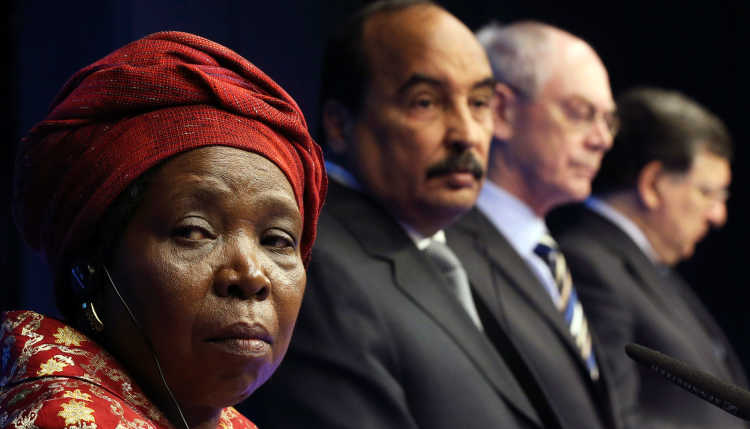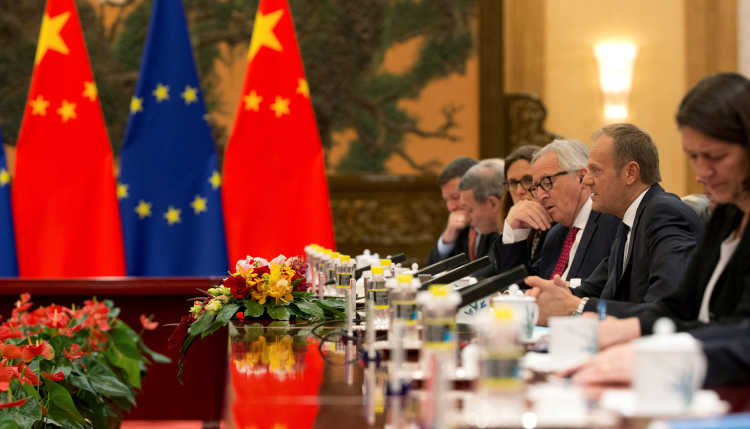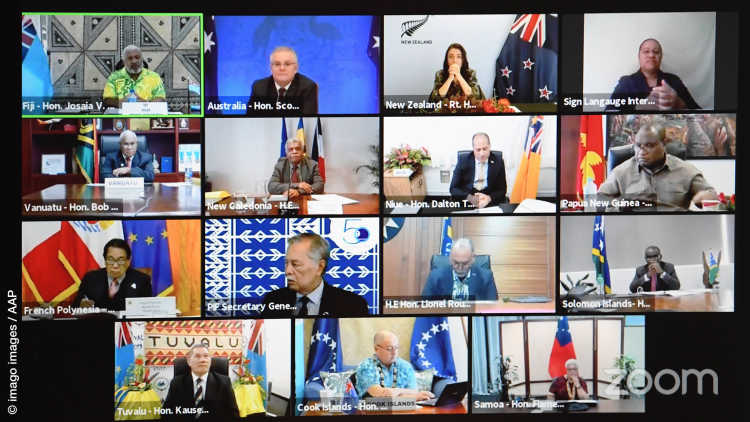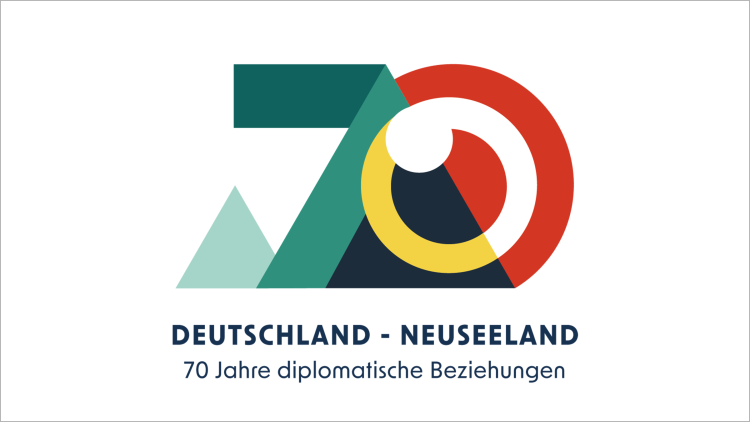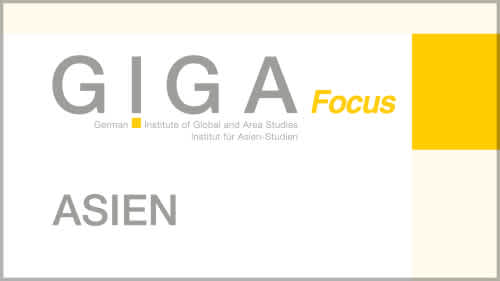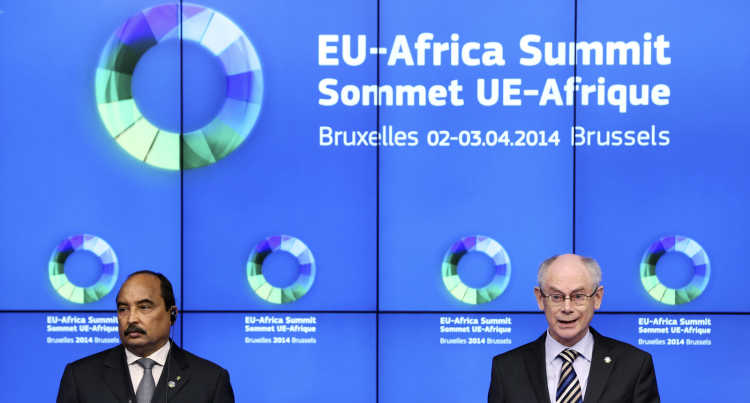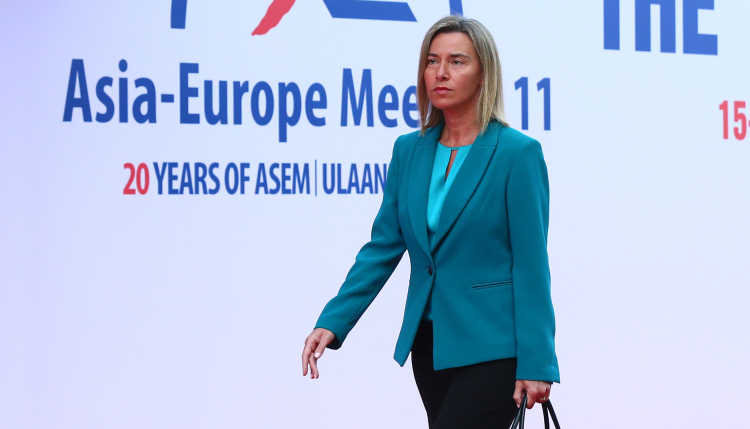- Home
- Publications
- GIGA Focus
- Towards a Comprehensive Partnership between the EU and New Zealand
GIGA Focus Asia
Towards a Comprehensive Partnership between the EU and New Zealand
Number 7 | 2016 | ISSN: 1862-359X
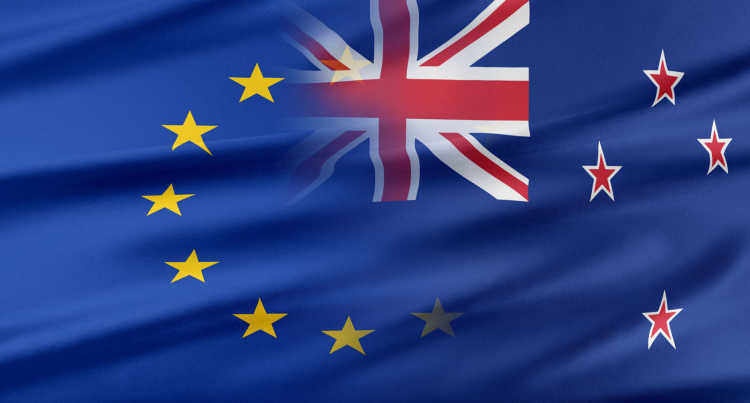
A history of substantial flows of people, goods, capital, ideas, and institutions binds the European Union (EU) and New Zealand. In October 2016, the comprehensive character of bilateral relations was reaffirmed with the signing of a Partnership Agreement on Relations and Cooperation (PARC). This treaty-level agreement will serve as a framework for future joint endeavours in a number of areas and may also pave the way for a free-trade agreement (FTA).
Despite the vast geographical space separating the EU and New Zealand, bilateral relations are fairly dense and diverse, having clearly outgrown the “trade only” stage.
Shared values and interests make New Zealand a well-regarded partner of the EU – at the bilateral level, in the regional context of the South Pacific, and on the international stage.
The PARC may well pave the way to a bilateral FTA, though this cannot be taken for granted given the rise of anti-globalist sentiments in the EU.
The United Kingdom accounts for a considerable share of the EU’s trade, investment, travel, migration, and other links with New Zealand. Brexit will thus hurt the EU’s relations with New Zealand – how much depends on the specific details of the divorce.
Policy Implications
While there are multifold rationales for an FTA with New Zealand, the benefits of such an agreement for EU citizens/consumers need to be clearly spelled out and public concerns need to be addressed when negotiating the FTA. Beyond trade, substantial scope exists for close EU–New Zealand collaboration in areas such as research and innovation. Given New Zealand’s status as a significant maritime nation, particular attention should be paid to cooperation on maritime affairs including and cutting across policy areas from climate change to security governance.
Putting EU–New Zealand Relations into Context
During the past two decades, the EU has signed a host of treaty-level agreements governing political and economic relations with partner countries in its neighbourhood and in other world regions. No EU partner country is located further away than New Zealand – nearly 19,000 kilometres and a travel time of more than 24 hours separate Brussels and Wellington. Despite the vast geographical space separating the two sides, bilateral relations are fairly dense and diverse. Long-standing historical ties of a political, economic, social, and cultural nature bind the EU and New Zealand together. Significant local adaptation notwithstanding, the institutional legacies of British rule as well as more recent institutional imports from Europe, such as a German-style mixed electoral system, shape New Zealand’s political system, while waves of migration from Europe have contributed in important ways to New Zealand’s social and cultural fabric. Building on this history of substantial flows of people, goods, capital, ideas, and institutions, New Zealand and the EU are in the process of effectively moving towards a comprehensive partnership. In the following, we take stock of the relationship, starting with a discussion of political and diplomatic relations before moving to trade, investment, tourism, and migration flows. In this context, we also address the rationale for and prospects of a bilateral free-trade agreement (FTA). In our conclusions we highlight, against the backdrop of the planned departure of the United Kingdom (UK) from the EU (Brexit), promising fields of future cooperation between the EU and New Zealand.
Institutionalised Political and Diplomatic Relations
Official ties between New Zealand and the EU have existed for well over 50 years. Diplomatic contacts were formally established in 1961, when a New Zealand ambassador became accredited to the then European Economic Community (EEC). New Zealand’s interest in closer contact with the EEC was stimulated by the UK’s interest in joining the EEC and the possible ramifications of this for New Zealand’s close trade ties with the former “motherland” (Holland and Kelly 2012). New Zealand’s relations with individual EU member states have traditionally focused on the UK and the two big EU core countries Germany and France.
Diplomatic and political relations between New Zealand and the EU, at both the supranational level and the level of individual member states, have become much more organisationally developed and structured over the past few decades. Important steps in this regard were taken with the opening of New Zealand embassies in Athens, Bonn, Brussels, and Rome in the 1960s and more recently also in other capital cities such as Madrid, Stockholm, or Warsaw. Of the 28 EU member states, eight have embassies in Wellington and 15 other member states are being accredited to New Zealand. There are also close to 50 consuls general and honorary consuls representing EU countries in New Zealand’s main cities. The collective EU diplomatic presence in New Zealand started with the accreditation of the European Commission Delegation in Canberra to New Zealand in 1984. In 2004, a direct diplomatic presence was established in Wellington, and six years later the Commission Delegation was transformed, in the context of the establishment of a joint EU External Action Service, into the European Union’s Delegation to New Zealand (Holland and Kelly 2012). In September 2016, the Delegation became a full mission led by a resident ambassador. Consultations between the EU and New Zealand at the level of political leaders, ministers, commissioners, and parliamentarians are frequent, and annual meetings of senior officials alternate between Brussels and Wellington.
The diplomatic and political relations between New Zealand and the EU are also characterised by the increasing complexity of the issues at play. Given the strong economic thrust of the initial European integration project and New Zealand’s long-standing quest to secure access to the European market for its exports, particularly agricultural products, it is not surprising that relations have until recently focused very much on trade and other economic matters, including quotas and regulatory issues. As an EU paper on relations with New Zealand put it bluntly some years ago: “Trade is a dominant feature of the bilateral relationship” (EEAS 2008). Indeed, many of the 15 bilateral agreements signed since 1980 by New Zealand and the EU (and its institutional precursors) deal with trade and business-relevant matters such as trade in cheese, mutton, lamb, and goat meat; sanitary, phytosanitary, and health issues; air services; and the mutual recognition of conformity assessments.
The Expanding Scope of EU–New Zealand Cooperation
Still, both the range of multilateral treaties, conventions, and protocols signed by the EU and New Zealand on issues such as climate protection and combating corruption or transnational organised crime as well as the issues covered in more recent bilateral agreements indicate that the scope of mutual interests, concerns, and cooperation is expanding. As a result, there are now sectoral dialogues involving officials from both sides on issues such as human rights and science and technology. Moreover, both sides also participate in the annual meetings of the ASEAN Regional Forum and in the bi-regional Asia–Europe Meeting process. The two sides also share a particular interest in regional cooperation, sustainable development, and stability in the South Pacific. Both the EU and New Zealand are important providers of development assistance for the nations in the South Pacific. Together with Australia, they have been engaged since 2008 in trilateral consultations on development cooperation in the region. They both also work together within the framework of the EU–Pacific Islands Forum, where issues of climate change mitigation and adaptation have featured prominently in recent years.
The basic foundation for developing bilateral relations in recent years has been the 2007 EU–New Zealand Joint Declaration on Relations and Cooperation, which superseded the first Joint EU–New Zealand Declaration signed in 1999. Underscoring the growing scope of issues at play, the 2007 declaration devoted only seven of 46 paragraphs dealing with the substance of the bilateral relations to trade and economic matters. The Joint Declaration was followed by a bilateral agreement on scientific and technological cooperation as well as two agreements dealing with security issues. The latter included one very specific agreement signed in 2007 that concerned New Zealand’s participation in the civilian EU Police Mission in Afghanistan – as one of four non-EU countries, New Zealand contributed police officers to the mission – and one agreement covering New Zealand’s participation in military crisis management operations in Bosnia and Herzegovina. A much broader framework agreement governing the participation of New Zealand in EU crisis management operations followed in 2012.
Building on the Joint Declaration and the subsequent bilateral agreements, the EU and New Zealand agreed in 2009 to further elevate the bilateral relationship by means of a comprehensive and legally binding EU–New Zealand treaty-level agreement. Formal negotiations on this Partnership Agreement on Relations and Cooperation (PARC) took place between 2012 and 2014. After some legal “scrubbing” of the text, EU High Representative Frederica Mogherini and New Zealand Foreign Minister Murray McCully finally signed the PARC in October 2016. This 60-article-strong document covers the whole gamut of bilateral cooperation and dialogue in ten sections, if not from A to Z, then at least from A for agriculture, rural development and forestry (Article 49), and animal welfare (Article 16) to T for transport (Article 48) or tourism (Article 28). Particularly lengthy and detailed articles concern cooperation in combating terrorism (Article 11), dialogue on economic and trade matters (Article 14), education and training (Article 40), energy (Article 47), and fisheries and maritime affairs (Article 50) (EEAS 2016).
The official discourse on EU–New Zealand cooperation, as displayed in official documents and statements by high-level representatives, emphasises the like-mindedness of the two parties. As the European External Action Service puts it: “The EU and New Zealand are like-minded partners who share many common values and interests and see eye-to-eye on key international and global issues” (EEAS n.d.). In turn, New Zealand Foreign Minister Murray McCully has called the EU “a partner of first order importance for New Zealand,” also noting “the high level of cooperation with the EU in the Pacific, including on development delivery” (European Union 2011). Arguably, the high esteem in which the two sides hold each other has contributed to the institutionalisation of political and diplomatic relations between the EU and New Zealand over the past few decades.
EU–New Zealand Trade Relations
While two elements of the “holy trinity” of the EU’s modern agreements with other countries and regions – the framework agreement for participation in EU crisis management operations mentioned above and an all-encompassing political agreement – are now in place with New Zealand, the often invoked “like-mindedness” of the two sides has yet to be translated into a bilateral FTA. Prior to Britain joining the EEC in 1973, New Zealand’s trade was largely conducted with the UK. In view of the gradual phasing out of preferential trading links with the UK, New Zealand had to reorient its trade relations. It did so by successfully diversifying its trade relationships with geographically closer Asian nations, as well as Australia.
Nevertheless, the EU has remained an important partner for New Zealand in terms of trade in both goods and services. In 2015, the EU was New Zealand’s third-most-important trade partner after Australia and China. New Zealand’s trade in goods and services with the EU accounted for approximately NZD 20 billion in that year, more than one-eighth of New Zealand’s total trade. The main goods exported to the EU were meat products, wine, and fruit. In the same year, the EU was the number one source of imports to New Zealand. Approximately 18 per cent of the goods and services imported came from the EU (Statistics New Zealand 2016a). The main EU merchandise items exported to New Zealand were transport equipment, mainly motor vehicles (close to 30 per cent of the total); machinery and appliances (approximately 25 per cent); and chemical and related products (European Commission 2016a).
Bilateral trade between the EU and New Zealand has continued to grow in recent years. According to EU statistics, EU imports increased on average by 2.2 per cent annually between 2011 and 2015, while EU exports to New Zealand increased by 7.4 per cent. New Zealand was the EU’s fiftieth most important trading partner worldwide in 2015, with 0.2 per cent of total EU trade being conducted with New Zealand. New Zealand has run a trade deficit with the EU since 2011, which amounted to EUR 1.1 billion in 2015 (European Commission 2016a). Slightly less than half of the deficit with the EU derived in 2015 from New Zealand’s bilateral trade with Germany, its most important trade partner within the bloc. In 2015, New Zealand’s trade with Germany amounted to over NZD 3.1 billion, while trade with the UK stood at NZD 3 billion. The fairly balanced trade with the UK accounted for approximately 21 per cent of New Zealand’s total trade with the EU (Statistics New Zealand 2016a) and thus, reflecting the long-standing trade ties between the two countries, a higher share than the UK’s contribution to the EU’s total external trade (close to 13 per cent for exports and 15 per cent for imports in 2015).
The Rationale for and Prospects of an FTA
New Zealand has long desired a bilateral FTA with the EU. As New Zealand’s minister of trade, Tim Groser, noted in 2014 in a letter to EU Trade Commissioner Cecilia Malmström, “New Zealand is now one of only six WTO members without a preferential access arrangement to the EU either concluded or under negotiation. This is out of keeping with our otherwise warm political relationship” (Groser 2014). In the absence of an FTA, New Zealand is at a disadvantage in terms of market access to the EU relative to some competitors. Given the political sensitivity of free trade in agricultural products for a number of member states, the EU has long been reluctant to initiate negotiations on such an agreement with New Zealand (or Australia for that matter). However, in view of the upcoming PARC and given New Zealand’s record of having successfully negotiated a number of high-quality FTAs with EU competitors such as China and South Korea, the EU and New Zealand committed in October 2015 to start the process of bilateral FTA negotiations.
Formal preparations got underway in early 2016 with public consultation processes on both sides. The EU Commission is in fact preparing to negotiate free-trade agreements with both New Zealand and Australia, with the one with New Zealand leading the way. According to the roadmap presented by the EU Commission in early 2016, the Commission could request permission from the European Council to begin FTA negotiations in the first part of 2017 (European Commission 2016b). The Commission’s preparations – impact assessment and scoping – for the negotiations with New Zealand and Australia have been unaffected by the outcome of the June 2016 referendum in the UK on leaving the EU. If anything, the spectre of Brexit has provided impetus for trade officials to conclude and ratify pending trade pacts sooner rather than later. However, given the rise of anti-globalisation sentiments (not only) in the EU, which in October 2016 nearly scuttled the signing of a trade pact between the EU and Canada (CETA), the more important question these days is whether an FTA between the EU and New Zealand will be sellable in all the EU member states, which also need to agree to the final deal.
Despite New Zealand’s limited importance for the EU’s external trade, concluding an FTA with New Zealand is arguably of interest to the EU on a number of counts. First, such an FTA could serve as a blueprint for future FTAs with partners in the Asia-Pacific and beyond. The content and explanation of such FTAs should address not only tariff issues, non-tariff barriers, and regulatory cooperation but also public concerns about trade- and investment-related issues (e.g. concerning data privacy, consumer protection, labour standards, or the investor-state dispute settlement system). The fact that such concerns are shared by many citizens in the EU and New Zealand as well as the already high level of regulatory cooperation between the two sides, even with regard to sensitive issues such as data privacy, provide good starting points, which do not exist with many other countries, for negotiations (cf. Lee-Makiyama 2015: 11–13).
Second, an FTA with New Zealand would open up opportunities for additional market access and provide links to existing trade pacts. New Zealand is not only connected to Australia by a common market scheme – the Closer Economic Relations (CER) agreement, which represents one of the world’s rare cases of deep regional integration – but also boasts a number of comprehensive FTAs with partners such as China and the Association of Southeast Asian Nations (ASEAN) with which the EU does not have FTAs. Indeed, due to its persistent, pragmatic, incremental, and multilaterally attuned approach to trade diplomacy over the past few decades, New Zealand is now enmeshed in a web of FTAs in the Asia-Pacific (see Leslie 2015), making it an attractive potential partner for the EU. An FTA with New Zealand could provide additional opportunities at the micro level for EU enterprises in Oceania and East Asia and could also provide a stepping stone at the macro level for wider interregional trade cooperation.
Third, given the EU’s and New Zealand’s expertise and experience in achieving high-quality FTAs as well as the already high degree of trade-related liberalisation and harmonisation between the two sides, there is the possibility that a bilateral FTA could be negotiated in a relatively swift and clean fashion. As Lee-Makiyama (2015: 9) has argued, if an FTA cannot be agreed upon with New Zealand, it cannot be agreed upon at all. With the EU’s ability to deliver in terms of external trade diplomacy – a core area of European integration – in doubt in recent times, the successful conclusion and ratification of an FTA with New Zealand could help rebuild trust and regain momentum in this policy domain. An EU–New Zealand FTA could be used to seek a new equilibrium between technocratic ambition on the one hand and public concerns on the other. Such an FTA will have to be more creative and more ambitious with respect to addressing citizen concerns about trade- and investment-related issues.
Also, given the public outcry in a number of EU member states about the secret character of negotiations between the EU and the US over the Transatlantic Trade and Investment Partnership (TTIP), the EU Commission and member states will need to discuss and decide on how much (more) information will be made available to the public before and during the envisaged FTA negotiations with New Zealand and Australia. Preparations for the trade pact might thus take longer than anticipated but will be vital for the trade pact to gain public approval and thus stand a chance of ratification. In a nutshell, the public will need to be convinced that such an FTA will be beneficial for them and not just for some vested interests. While an EU–New Zealand FTA has finally moved into sight with the signing of the PARC, actually concluding an FTA will still require proper preparation and explanation.
Direct Investment, Tourism, and Migration
In terms of accumulated foreign direct investment (FDI), the EU ranks second in importance for New Zealand, trailing Australia by a wide margin. At the end of 2015, the total stock of EU FDI in New Zealand amounted to NZD 8.3 billion or close to 9 per cent of the total. By country, most FDI from the EU has originated from the UK (NZD 4.2 billion), followed by the Netherlands (NZD 3.5 billion). In terms of New Zealand’s overseas direct investment (ODI), the EU has been the third-most important destination for such investment, with accumulated ODI amounting to NZD 2.9 billion or 11.4 per cent of the total stock at the end of 2015. More than half of New Zealand’s ODI in the EU has gone to the UK (Statistics New Zealand 2016a).
Tourism is of vital importance to New Zealand’s economy, contributing in direct and indirect terms over 8 per cent of the country’s GDP. Growth in the tourism sector has in recent years been driven by the increasing number of Asian, in particular Chinese, visitors to New Zealand. Still, the number of visitors from the EU remains high and continues to grow. According to New Zealand statistics, approximately 463,000 people from Europe visited the country in 2015, making it the third-largest source of worldwide visitors after Oceania and Asia but before the Americas. By country, visitors from both the UK and Germany featured in the top 10 in 2015 – with the UK at fourth place with close to 204,000 visitors and Germany at sixth place with close to 85,000 visitors (Statistics New Zealand 2016b).
The high number of visitors from the UK can be easily understood in light of New Zealand’s immigration profile. Nearly three-quarters of the population – roughly three million people – identify themselves as being of European ethnicity. A quarter of the population was born overseas. While the largest group of overseas-born New Zealanders now hails from various parts of Asia, England still ranks at the top by country – well ahead of China, India, and Australia – with close to 216,000 people, or 21.5 per cent of New Zealand’s overseas-born population, originating from there. The other European source of overseas-born citizens in the top 10 is Scotland, where close to 26,000 New Zealanders were born (Statistics New Zealand 2013).
Permanent migration from the EU to New Zealand remains substantial. In the year ending March 2016, over 26,500 EU citizens resettled in New Zealand, accounting for more than one-fifth of all immigrants in that year. Collectively, EU citizens were in fact the most important group of new immigrants, outnumbering Australians and Chinese. Europeans arriving on a permanent or long-term basis in New Zealand in 2015 included nearly 13,400 Brits, over 3,900 Germans, and close to 3,800 French citizens (Statistics New Zealand 2016a, 2016c).
Beyond Brexit: The Potential for Closer EU–New Zealand Cooperation
While New Zealand’s ties with Australia and various parts of Asia have grown by leaps and bounds in recent decades, the EU undoubtedly remains a first-order partner for New Zealand. Very substantial trade, investment, tourism, and migration ties continue to underpin bilateral relations. Shared values and interests also make New Zealand a well-regarded partner of the EU – at the bilateral level, in the regional context of the South Pacific, where New Zealand features as a “middle power” in its own right, and on the international stage. Relations between the EU and New Zealand have clearly outgrown the “trade only” stage. Nevertheless, the UK’s planned exit from the EU will have significant ramifications for the relationship. Because of the UK’s historically based special place in New Zealand’s relations with Europe and because the UK still accounts for a disproportionate share of the EU’s trade, investment, travel, migration, and other links with New Zealand, Brexit will undoubtedly mean a net loss for the EU’s relationship with New Zealand. Given the still-unclear timing and conditions of Brexit, including whether the UK will remain connected to the Single Market in some way or for some time, the only thing that can be said with certainty at this point is that New Zealand will need to negotiate of host of separate agreements with the UK after Brexit has occurred – that is, most likely after 2019.
The spectre of Brexit notwithstanding, there is substantial scope for further developing relations between the EU and New Zealand. The treaty-level agreement signed this year is bound to serve as a launching pad for future joint endeavours in a number of areas and may also pave the way for a bilateral free-trade agreement. While the relationship between the EU and New Zealand is unlikely to evolve into a genuine strategic partnership (cf. Narlikar and Plagemann 2016) given New Zealand’s limited capacities for global engagement on a large scale, the PARC testifies to the comprehensive character of the bilateral relations.
Areas of cooperation with particular potential for further development include research and education as well as maritime affairs. For a country with a population of 4.6 million, New Zealand boasts fairly substantial links with the EU and its member states in terms of research, innovation, and education. Innovation systems in the EU and New Zealand are in alignment, and some of the key priorities of publicly funded research in the EU and New Zealand are the same. The number of New Zealand participations within the EU Framework Programmes (FP) for Research and Technological Development has significantly increased since the signing of the Science and Technology Cooperation Agreement in 2009. While less than 30 participants from New Zealand took part in FP 6 (2002–2006), there were approximately 230 such participants in FP 7 (2007–2013), including the Marie Skłodowska-Curie mobility programme and joint research in the areas of food, agriculture and fisheries, biotechnology, information and communications technology, and health (European Commission 2013). The current EU Research and Innovation Programme, Horizon 2020 (2014–2020), which also includes public–public partnership networks, should see even more New Zealand participation, particularly given New Zealand’s expertise and interest in additional areas such as renewable energy, resilient structures, sustainable urban development, and Antarctic research (cf. European Commission 2016c: 33–34).
Beyond, but in some ways also linked to, cooperation in research, innovation, and education, there is also scope for more in-depth cooperation between New Zealand and the EU concerning maritime affairs. New Zealand is a significant maritime nation with one of the longest coastlines and also one of the largest exclusive economic zones (EEZs) on the globe. Future cooperation and dialogue between the EU and New Zealand should better reflect shared maritime and marine interests, as well as responsibilities, by addressing issues across a range of policy areas including, but certainly not limited to, climate change (e.g. ocean acidification), energy (e.g. generation of energy from ocean currents), natural disaster management (e.g. the improvement of relevant governance structures in the South Pacific), research and innovation (e.g. aquaculture, ocean monitoring), security governance (e.g. peaceful settlement of maritime disputes), and the sustainable development of the marine environment (incl. conservation, protection, and rehabilitation of ocean ecosystems). While such issues can be addressed on an issue-by-issue basis, a more integrated approach could build on existing and yet-to-be-established framework policies for ocean governance in the EU and New Zealand. A comprehensive maritime partnership between the EU and New Zealand could form a bedrock of bilateral relations in the years to come.
Footnotes
References
EEAS (European Union External Action Service) (2016), Partnership Agreement on Relations and Cooperation Between the European Union and its Member States, of the One Part, and New Zealand, of the Other Part, https://eeas.europa.eu/sites/eeas/files/eu_new_zealand_partnership_agreement_on_relations_and_cooperation.pdf (17 October 2016).
EEAS (European Union External Action Service) (2008), Political and Economic Relationship with New Zealand, http://eeas.europa.eu/new_zealand/docs/political_economic_en.pdf (24 May 2015).
EEAS (European Union External Action Service) (n.d.), EU’s Relations with New Zealand, http://eeas.europa.eu/new_zealand/index_en.htm (28 April 2015).
European Commission (2016a), European Union, Trade in Goods with New Zealand, http://trade.ec.europa.eu/doclib/docs/2006/september/tradoc_113425.pdf (16 August 2016).
European Commission (2016b), Inception Impact Assessment: EU-Australia and EU-New Zealand Free Trade Agreements, http://ec.europa.eu/smart-regulation/roadmaps/docs/2015_trade_040_aus_nz_trade_agreement_en.pdf (14 October 2016).
European Commission (2016c), Priorities for International Cooperation in Research and Innovation, SWD (2016) 329 final, www.kowi.de/de/Portaldata/2/Resources/horizon2020/wp/annex_roadmaps_oct-2016.pdf (26 October 2016).
European Commission (2013), European Union-New Zealand Science and Technology Cooperation Roadmap 2014–2016: Research and Innovation Priorities, https://ec.europa.eu/research/iscp/pdf/policy/new_zealand-eu_priorities.pdf (20 October 2016).
European Union (2011), European Union and New Zealand to pursue Framework Agreement, http://europa.eu/rapid/press-release_IP-11-1288_en.htm (28 April 2015).
Groser, Tim (2014), Congratulations Letter to Commissioner Malmström, http://ec.europa.eu/carol/index.cfm?fuseaction=download&documentId=090166e59b144f7a&title=Commissioner_Malmstr%C3%B6m%20-%20from%20NZ%20MoT%20Tim%20Groser.pdf (15 April 2015).
Holland, Martin, and Serena Kelly (2012), Britain, Europe and New Zealand. Te Ara – The Encyclopedia of New Zealand, www.TeAra.govt.nz/en/britain-europe-and-new-zealand/print (24 October 2016).
Lee-Makiyama, Hosuk (2015), New Zealand: The EU’s Asia-Pacific Partnership and the Case for a Next Generation FTA, ECIPE Policy Brief No. 07/2015, http://ecipe.org/publications/new-zealand-eus-fta/ (24 October 2016).
Leslie, John (2015), New Zealand Trade Strategy and Evolving Asian-Pacific Regional Economic Architecture, Asia New Zealand Foundation Report, www.asianz.org.nz/reports/wp-content/uploads/2015/01/ANZF1034-Trade-Strategy-Report-_-FA.pdf (25 October 2016).
Narlikar, Amrita, and Johannes Plagemann (2016), Making the Most of Germany’s Strategic Partnerships: A Five-Point Proposal, GIGA Focus Global, 6, Hamburg: GIGA, www.giga-hamburg.de/en/publication/making-the-most-of-germanys-strategic-partnerships-a-five-point-proposal (27 October 2016).
Statistics New Zealand (2016a), Global New Zealand – International Trade, Investment, and Travel Profile: Year Ended December 2015, www.stats.govt.nz/browse_for_stats/industry_sectors/imports_and_exports/global-nz-dec-15.aspx (16 August 2016).
Statistics New Zealand (2016b), International Visitor Arrivals to New Zealand: December 2015, www.stats.govt.nz/browse_for_stats/population/Migration/international-visitor-arrivals-dec-15.aspx (3 February 2016).
Statistics New Zealand (2016c), European Union-New Zealand Trade, Investment, and Migration: Year Ended March 2016, www.stats.govt.nz/browse_for_stats/industry_sectors/imports_and_exports/trade-investment-migration-factsheets.aspx (16 August 2016).
Statistics New Zealand (2013), 2013 QuickStats: About National Highlights, www.stats.govt.nz/Census/2013-census/profile-and-summary-reports/quickstats-about-national-highlights.aspx (28 April 2016).
General Editor GIGA Focus
Editor GIGA Focus Asia
Editorial Department GIGA Focus Asia
Regional Institutes
Research Programmes
How to cite this article
Patrick Köllner (2016), Towards a Comprehensive Partnership between the EU and New Zealand, GIGA Focus Asia, 7, Hamburg: German Institute for Global and Area Studies (GIGA), http://nbn-resolving.de/urn:nbn:de:0168-ssoar-51517-9
Imprint
The GIGA Focus is an Open Access publication and can be read on the Internet and downloaded free of charge at www.giga-hamburg.de/en/publications/giga-focus. According to the conditions of the Creative-Commons license Attribution-No Derivative Works 3.0, this publication may be freely duplicated, circulated, and made accessible to the public. The particular conditions include the correct indication of the initial publication as GIGA Focus and no changes in or abbreviation of texts.
The German Institute for Global and Area Studies (GIGA) – Leibniz-Institut für Globale und Regionale Studien in Hamburg publishes the Focus series on Africa, Asia, Latin America, the Middle East and global issues. The GIGA Focus is edited and published by the GIGA. The views and opinions expressed are solely those of the authors and do not necessarily reflect those of the institute. Authors alone are responsible for the content of their articles. GIGA and the authors cannot be held liable for any errors and omissions, or for any consequences arising from the use of the information provided.





